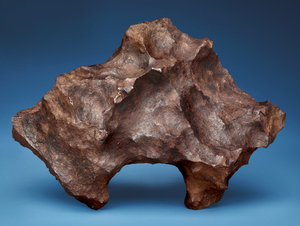CANYON DIABLO METEORITE FROM METEOR CRATER — LARGE SELECT INDIVIDUAL, Iron — Coarse octahedrite IAB-MG Meteor Crater, Coconino County, Arizona
Canyon Diablo meteorites are noted for containing graphite and sulfide nodules and carbonados (minute black diamonds). It was the weathering away of the graphite and nodules that resulted in the sculpting of the furrows and basins of this meteorite. In a process referred to as terrestrialization, small sockets expanded in size when exposed to Earth’s elements as the seasons turned over a period of tens of thousands of years. A surface of peaks and ridges animate the form. Wrapped in a cinnamon to a milk chocolate-hued patina.
189 x 281 x 143 mm. (7½ x 11 x 5⅔ in.) and 14.5 kg. (32 lbs)
A choice representation of one of the most famous meteorite events the world has known. Like all iron meteorites, the current offering is more than four billion years old and originated in the asteroid belt between Mars and Jupiter. This meteorite was once part of a huge mass that was blasted off an asteroid and eventually deflected into an Earth-crossing orbit. Approximately 49,000 years ago it plowed into the Arizona desert with the force of more than 100 atomic bombs. Fragments were ejected more than 11 miles away from the point of impact and the main mass vaporized, creating the most famous and best-preserved meteorite crater in the world — the renowned Meteor Crater near Winslow, Arizona nearly one mile across and 600 feet deep. The fragments of iron that survived the impact are referred to as Canyon Diablos (“Canyon of the Devil”), and they are the quintessential American meteorite, prized by museums and private collectors everywhere.
The Canyon of the Devil became precisely that for one Daniel M. Barringer. At the turn of the 20th Century, Barringer reasoned that the crater had to have been created by an enormous extraterrestrial mass weighing millions of tons. He believed this mass, worth a fortune in nickel and iron, lay under the crater’s base. In 1903 Barringer filed a mining claim and commenced a drilling operation that went on for years. Unfortunately for Barringer, scientists later determined that a mass much smaller than what Barringer believed existed would possess sufficient energy to blow the huge hole in the desert floor — and would also generate enough heat to vaporize much of itself. In effect, what Barringer spent the last decades of his life looking for didn’t exist — but this extraordinary meteorite does, as does the best-preserved meteorite crater on Earth. The Barringer Family maintains the crater and adjacent museum today in what is a major international tourist attraction, not to be missed by any reader.
Christie's would like to thank Dr. Alan E. Rubin at the Institute of Geophysics and Planetary Physics, University of California, Los Angeles for his assistance in preparing this catalog note.
View it on
Sale price
Estimate
Time, Location
Auction House
Canyon Diablo meteorites are noted for containing graphite and sulfide nodules and carbonados (minute black diamonds). It was the weathering away of the graphite and nodules that resulted in the sculpting of the furrows and basins of this meteorite. In a process referred to as terrestrialization, small sockets expanded in size when exposed to Earth’s elements as the seasons turned over a period of tens of thousands of years. A surface of peaks and ridges animate the form. Wrapped in a cinnamon to a milk chocolate-hued patina.
189 x 281 x 143 mm. (7½ x 11 x 5⅔ in.) and 14.5 kg. (32 lbs)
A choice representation of one of the most famous meteorite events the world has known. Like all iron meteorites, the current offering is more than four billion years old and originated in the asteroid belt between Mars and Jupiter. This meteorite was once part of a huge mass that was blasted off an asteroid and eventually deflected into an Earth-crossing orbit. Approximately 49,000 years ago it plowed into the Arizona desert with the force of more than 100 atomic bombs. Fragments were ejected more than 11 miles away from the point of impact and the main mass vaporized, creating the most famous and best-preserved meteorite crater in the world — the renowned Meteor Crater near Winslow, Arizona nearly one mile across and 600 feet deep. The fragments of iron that survived the impact are referred to as Canyon Diablos (“Canyon of the Devil”), and they are the quintessential American meteorite, prized by museums and private collectors everywhere.
The Canyon of the Devil became precisely that for one Daniel M. Barringer. At the turn of the 20th Century, Barringer reasoned that the crater had to have been created by an enormous extraterrestrial mass weighing millions of tons. He believed this mass, worth a fortune in nickel and iron, lay under the crater’s base. In 1903 Barringer filed a mining claim and commenced a drilling operation that went on for years. Unfortunately for Barringer, scientists later determined that a mass much smaller than what Barringer believed existed would possess sufficient energy to blow the huge hole in the desert floor — and would also generate enough heat to vaporize much of itself. In effect, what Barringer spent the last decades of his life looking for didn’t exist — but this extraordinary meteorite does, as does the best-preserved meteorite crater on Earth. The Barringer Family maintains the crater and adjacent museum today in what is a major international tourist attraction, not to be missed by any reader.
Christie's would like to thank Dr. Alan E. Rubin at the Institute of Geophysics and Planetary Physics, University of California, Los Angeles for his assistance in preparing this catalog note.



